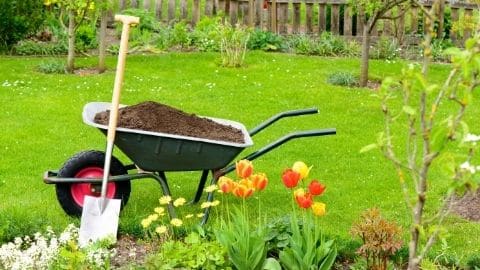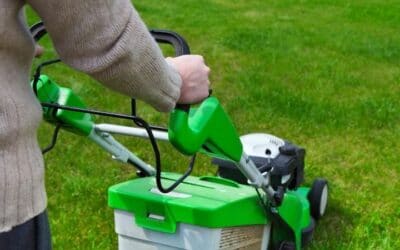When to Start Mowing Lawn | The First Cut of The Year

Lawn mowing is not an event confined to a specific calendar date. Instead, you should monitor your grass length and mow only when necessary. Every homeowner or gardener needs to know when to start mowing lawn to maintain a clean and neat grass cut. This article will help you establish the right time to start mowing your lawn.
I am confident that after this read, you will know the right time to mow. Every season has its mowing needs. Below I will look at when you need to start mowing in every season. I will also elaborate on the optimum length of mowing grass.
Start Mowing Your Lawn
Spring
The first mow of the year is usually in the first week of April. This is when spring begins. It is a growing and blooming season for your lawn. The lawn grows fast this season, and it will only be a week into spring before the lawn needs mowing. You need to be sure of when to start mowing the lawn to avoid damaging or harming it. A mow too early or late might ruin the entire spring look.
You may think you need to cut down the first growth of lawn you see in spring. However, you need to allow your lawn a week or two to recover naturally from harsh winter conditions. Seed new grass if necessary and will enable it to grow before the first mow of the year.
Spring season naturally prompts growth. Seeing the first gust of growing lawn, you might feel compelled with the desire to cut it down immediately. Apart from the need to recover, it is also best to allow a bit of natural lawn activity. This will promote a healthy lawn throughout the season and beyond. Perfect timing during the spring season will guarantee you an entire season of a lush green lawn. Mowing at the right time will also encourage healthy lawn activity to keep it vibrant even after spring.
Summer
Following spring is the summer season, which is hot and dry. In extreme cases, summer is even characterized by drought. Your lawn needs to retain as much moisture as it can during this season. This implies that you will have to start mowing later on into the summer season.
Usually, you will need to start mowing approximately two weeks into summer. Warmer summer conditions will allow you to mow earlier. Rich flower lawns that shine and flourish during the summer season are more resistant to hot weather and can be mowed even in the first week of summer. Long grass lawns may require regular mowing as well.
Autumn
Mowing should start a week or two after the autumn season begins. Autumn is a windy season with a bit of rainfall in some areas. Growth usually is steady during this time. It is the last mowing season of the year.
You will need to start mowing your lawn when it grows to 1 ½ to 2 inches in the season. A good watering schedule will help maintain your lawn lush green in autumn that grows well and requires frequent mowing. End autumn with a clean-cut long. Although common myth is to cut the grass short to sustain it through the winter season. A low cut will make your lawn more vulnerable to winter diseases.
Winter
Mowing is not necessary during the winter season. This is the coldest time of the year; it is a time when your lawn is more vulnerable to frostbites and thatch. Mowing in harsh weather conditions is a risk not worth taking. The chances your lawn will be useless after a winter mow are very high. Therefore, if the great need arises and winter mow is inevitable, it is best to wait for the winter conditions to lighten first.
You should only start mowing when the winter weather conditions are mild. Consequently, only mow the lawn occasionally. Use a high cut setting to avoid cutting the grass too short during winter. Do not, by any means, try to mow your lawn during cold, harsh weather conditions, especially when there is a cold spell, snow, or extremely dry winds.
Optimum Mowing Length
Lawn experts recommend that you start mowing your grass before it exceeds 2 inches. It is also under advisement not to cut over a third of the lawn at a time. Cutting more at a time will harm the grass root system, making the grass weak and vulnerable to grass weeds. It also exposes your grass to diseases that are bad for the lawn.
Sometimes one third is not enough. It still leaves your grass too long than you want it to be. This is usually after a long winter of growing and little or no mowing. Even so, it is still recommended to cut off only a third at a time, even if it means cutting your grass every week for a period. You need to maintain the one-third rule as you cut your grass until it reaches your desired length. Cut down the grass bit by bit, allowing it to adjust to a new length before chopping it down more.
Therefore, to avoid mowing in series to get your grass short enough, you should make sure to start mowing your grass when cutting a third of it will leave the lawn just as you like it
Other factors influencing to start mowing the lawn:
New grass
Winter usually leaves behind bare spots that call for overseeding. This is a process of planting new grass over already grown grass to fill patches or make grass fuller. New grass needs to mature first before you start mowing. The new grass that sprouts from overseeding is fragile and easily damaged. It needs to be allowed time to grow and develop a robust root system before mowing.

Garden experts recommend that new grass is more likely to survive a mow after three inches long. They advise against cutting new grass sooner than that as expected to damage or kill the grass. You can start mowing your grass a few weeks after the new grass has grown and matured.
Clean up
Clean your lawn to avoid accidents, get rid of dirt and rabble that might damage your mower. a little pruning of the trees around is also necessary to ensure the mowing area is safe.
When you start mowing, the last thing you need is hitting stones, rabble, and crushing twigs into the lawn. You should begin to mowing after you have cleaned and cleared your grass of any twigs, sticks, as well as thatch that has built up over winter. Make sure to tidy up before mowing for a hazard-free mowing environment.
Servicing your mower
Start mowing after giving your lawnmower a good service. After a whole season of no use, your mower blades will need sharpening. Also it is important to change oil and clean filters before you start mowing. When the need arises, you can even take the mower to a professional mow service provider. Gear up your mowing tools and start mowing.
Warm weather
To be sure when to start mowing the lawn, you must wait for warm weather temperatures. A few days after the sun breaks out, you are good to begin mowing. This is because warm, sunny weather conditions will encourage the grass to grow faster. You need not wait to overgrow your lawn before cutting it down once again. Doing so will damage the lawn’s root system and development.
Fertilizer application
Before you start mowing your grass, you need to consider when last you fertilized your grass. And you should allow the lawn to take up nutrients from the fertilizer before mowing. This gives the lawn enough food to sustain it even after the cut.
You must allow a grace period after fertilizing before mowing. It will enable the grass to absorb and use the fertilizer before mowing fully. Usually, the best time to fertilize is late or early spring; therefore, you should start mowing a few days after.

Fertilizer Application
Weed-killer application
Whether you are using a pre-emergent or post-emergent weed killer, you should start mowing after application. You need to allow the weed killer a few days or weeks to absorb itself into the weed plants before a mow. Post-emergent weed killers only work on the growing lawn. They are useless on the stagnant lawn. Therefore, schedule the start of your mowing season a few days to a week after your weed killer application.
Watering
After scheduling the time when mowing the lawn, do not water it a day before or on the day. Wet grass is slippery, and trying to mow it is an impossible task. Mowing wet grass can leave different undesired lengths that will make your grass look unkempt. The best time to start mowing would be a day or a few hours before you are scheduled to water your lawn.
Location
Where you stay and grow, your grass will significantly impact when to start mowing your lawn. This is because of the different climatic conditions in regions and places. In some areas, mowing starts earlier in the year, and others start later.
Some areas have more prolonged winter pushing sunny days further down the year and forcing mowing to later months. Other regions have freezing weather conditions throughout the year, with only a few months of sunshine. Despite the location you are in, you need to wait for warm sunny conditions to show up before you start mowing.
Lawn mowing in freezing conditions is dangerous for your lawn. And it might even cause permanent, irreversible damage to the lawn. Thawing may cause lawn dehydration, and the last thing your lawn needs in such a time is a mow.
Final Verdict
As much as you might love mowing and are ready to do so as often as time allows, you need to schedule mowing time. You must know when to start mowing the lawn during the year and pause mowing for the year. A perfect timely schedule will guarantee you a vibrant, lush green lawn throughout the year.
The first appearance of growth might tempt you to pull out your mower and cut it off. You need to consider what is best for your lawn. Study the weather, reflect on the lawn’s maturity, and establish when it is best to start mowing your lawn.
Lawn mowing is not just a haphazard event that occurs anytime; instead, it is a scheduled event. Cutting grass too short will damage and stunt its growth. On the other hand, mowing too long grass will also disrupt the root system. It is, therefore, essential to establish the best time to mow your lawn.

Kazi Taslim
Editor
Poweredgrip ensures that an expert team of writers provides you with excellent, unbiased informational content. We are dedicated to giving you the most up-to-date and smoothest information possible. We share incomparable tips and tricks that give you awareness and confidence when making your buying decisions. Our team is enthusiastic, dedicated, and hardworking. Kazi Taslim is the editor and head of our experienced writing team.
Related Post
How Often to Mow Lawn: Guide to Avoid Mowing Mistakes
It is said sweet comes from sweat. The same goes for achieving a good lawn. You do not just wake up one day and see a beautiful lawn in your yard. You need to maintain your lawn if you want it to be healthy and beautiful. Mowing grass is a must-do if you're going to...
Best Time to Plant Grass Seed | Step By Step Guide
If you want to achieve a healthy, lush lawn, it is essential to properly plant your grass seed. Proper timing will allow your grass seed to germinate well and get established well before unfavorable weather conditions and stresses come. If your planting season aligns...
When to Aerate Lawn I Complete Lawn Aeration Guide
Lawn aeration is vital for the reduction of turf's thatch layer and for combating soil compaction. For the aeration to be adequate, you must carry it out at a specific time depending on a set of conditions, including the cultivar or type of lawn, weather...
Organic weed control for lawns | Natural weed controlling Tips
As a gardener, you could spend a lot of time and effort on nurturing your lawn. While helping it reach its optimum potential, on the dawn of your contentment, you notice the presence of weeds, which seem to be thriving. Weeds are not as friendly as they could disturb...
Lawn Care Schedule for All the Year Round
Having a lawn care schedule can be pretty rewarding if your goal is to have a lush lawn. All year-round, you need to take proper care of your lawn, and this involves applying fertilizer, mowing, watering, edging, dethatching, etc. For every lawn care activity, proper...
When to Fertilize Lawn: A Complete Fertilizing Tips
To a certain extent, lawns are somewhat similar to human beings. They require a good diet and proper care for them to perform highly and stay beautiful. For instance, green and lush lawns depend on properly timed, balanced nutrition to look and develop to their best;...







Trackbacks/Pingbacks